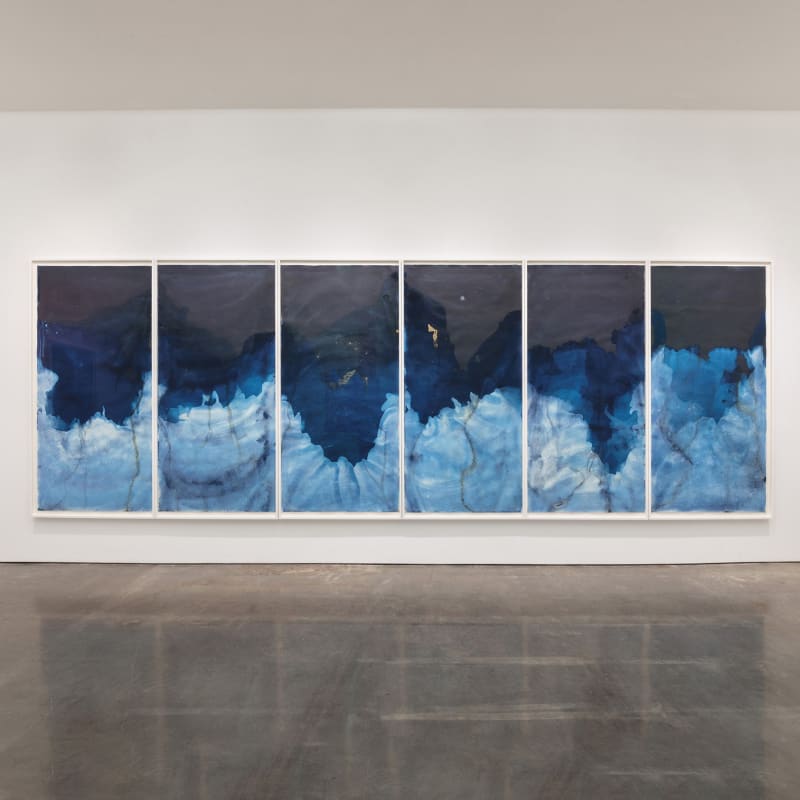Meghann Riepenhoff's cyanotype prints bridge the physicality and symbolic nature of art making in conjunction with nature's phenomenal forces. This collaboration, between artist and ecology, is an alluring and artful representation of environmental cycles and humanity clashing together in the Anthropocene. Riepenhoff's cyanotypes react to changing climates and ecosystems, which are affected by both human interaction and natural forces. The prints are part artistic exploration and part scientific experimentation. They are qualitative interpretations and creative expressions of the quantitative data and scientific analysis that measure weather patterns, natural cycles and humanity's impact on the environment.
Riepenhoff's choice of medium, materials and themes are in dialogue with the past and present fields of aesthetics and science. Cyanotypes are well suited for studying the living environment, as well as producing works of art. Invented in the early-mid 19th century, the alternative photographic process was popularized by Anna Atkins, a botanist and photographer from England. Atkins utilized cyanotypes as a way to document the intricacies of plants and other natural objects by combining her astute eye as a photographer with her knowledge of plant taxonomy. She printed limited edition books of her prints, including Photographs of British Algae: Cyanotype Impressions (October, 1843), which is considered to be the first book illustrated with photographs.
Riepenhoff's cyanotypes offer a potent depiction of the stress we put on our environment. Littoral Drift #1170 (Polyptych, Great Salt Lake, UT 08.25.18, Lapping Waves at Shoreline of Antelope Island) was created by placing a sheet of paper prepared with cyanotype chemistry on the shoreline of the south side of the Great Salt Lake in Utah, which is experiencing record low water levels. The Great Salt Lake is divided by a causeway built in the 1950s by the Morrison-Knudsen construction company for the Southern Pacific Railroad. The causeway has restricted the flow of the water between the north and south sides, making levels of salinity uneven and affecting wildlife such as the brine shrimp population. The two sides of the lake are notably different colors and altogether the lake is characterized as an ecotone, which is defined as a region of transition where two or more distinct biological habitats abut. Riepenhoff juxtaposed the south shoreline print with works made on the opposite side of the lake, to symbolize the aesthetic difference in each region's water composition. This process is akin to the scientific method where systematic observation and measurement are used to test a theory, in this case: what is the difference in water quality on opposite sides of the Great Salt Lake due to its status as an ecotone?
Riepenhoff also explores the aesthetic and vigorous qualities of storm water in another series of cyanotypes called Erasures. These prints are made when the storm runoff hits the prepared cyanotype paper. The length of the storm and the volume of water washing away large quantities of the cyanotype chemistry, results in a light tone with marks that recall painterly brushstrokes.
Data for weather and climate in the form of graphs and Doppler imagery is something that we rely on heavily each day. These data sets tell us about what to expect, but it is often hard to envision the environmental impact of the meteorological event until it is experienced. Art has a compelling way of making implied information relevant to our sense of visual perception, while leaving room for the viewer to interpret and include experiential elements.
Riepenhoff's artwork visualizes the intricate force and physicality of storms and the variance of ecosystems in real time. The resulting engagement with nature is a subjective approach to capturing the essence of the biosphere and our individual interactions with nature. She can't control the strength of a wave, the duration of the rainfall or the strength of the storm, but she makes a conscious effort to decide where to place her paper and how long to leave it out in the elements. The overarching result is a body of work that traces both the environment's volatility and the artist's deliberate choices.
This duality between consciousness and exploration is a crux of artful learning. The arts help us to develop critical thinking and flexible purposing skills that probe and conceptualize natural and cultural phenomena. The benefit of art-centered learning in scientific research and educational curricula, is that it adds an element of lived experience and personalization to a field largely engrossed in quantitative data and academic research. Art illuminates the ways that we interact with our environment and each other, and its captivating properties can raise awareness for issues affecting our shared natural resources. This is the case for Riepenhoff's work, which subtly and discerningly depicts our interaction with the rest of the natural world.

